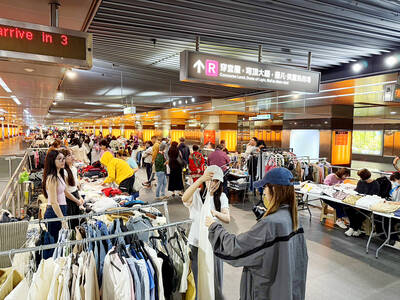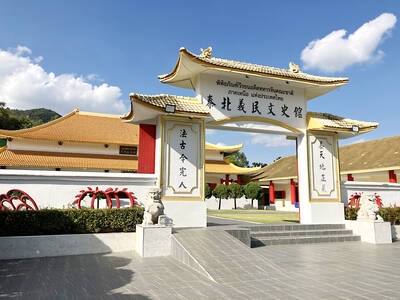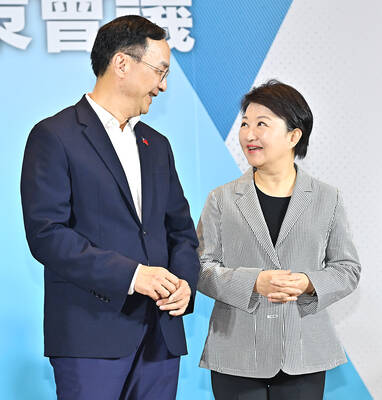Choreographer Huang Yi (黃翊) is a young man in love with bodies, movement, speed and technology. Especially technology.
He’s also a young man in a hurry. He will finally finish school in June, graduating from the Taipei National University of the Arts with a master’s of fine arts in choreography. Graduation means he’ll have to put his career on hold for a year while he completes his mandatory military service. Being on hold is not something that one associates with Huang.
He has already carved out a sizeable reputation. He has worked with Cloud Gate 2 (雲門2舞集) for the past two years, collaborated with Horse (驫舞劇場), won the 2007 Taishin Arts Award for Horse’s Velocity, been invited to perform in France, created an installation piece for the National Taiwan Museum of Fine Arts and been invited by the National Theater to create a piece for the Experimental Theater. And he’s just 26.
Starting tonight, he will present Spin 2010 for five shows at the Experimental Theater — four of which are already sold out. The 50-minute Spin 2010 builds on work Huang has been doing since 2006, creations that combine his love of dance and his love of video.
In 2006 Huang made a video he shot while moving next to the dancers. He used that video to apply for a Lo Man-fei (羅曼菲) dance scholarship grant in 2007 and spent the grant on a crane arm to hold his camera. He used the crane to create a piece to take to France that same year and to create the Taichung installation in 2008.
“The first (2006), second (2007) and third year (2008) I did different things. The first was a lot of improvisation,” Huang said in a telephone interview on Monday. “In 2007, the crane was spinning, it was controlled by hand so we didn’t know where it would go, where it would stop ... In 2008 everything was set ... how many circles the crane will go, how many degrees [up or down].”
Last year was spent working on the technology and on Spin 2010.
“In 2010 everything was auto control. We added LED lighting and a [laser] projector for the lighting,” he said. “Visually it’s very different from before. This time I added many upside down video or mirror effects.”
Not only has the technology grown, so has the number of dancers, which means more avatars to play with. Huang used five for the 2007 and 2008 projects, but expanded to 10 for this weekend’s show. As of Monday night, however, he was down to nine, possibly eight, because of injuries.
This is a much bigger production than he has ever had to deal with before — it’s not just the number of dancers, there’s also Fishbone, which built the crane (see the Youtube video at http://bit.ly/d1SdLo), and a much larger production crew. Huang even hired a manager.
A very calm-sounding Huang, however, said he wasn’t nervous, just excited about the show.

May 26 to June 1 When the Qing Dynasty first took control over many parts of Taiwan in 1684, it roughly continued the Kingdom of Tungning’s administrative borders (see below), setting up one prefecture and three counties. The actual area of control covered today’s Chiayi, Tainan and Kaohsiung. The administrative center was in Taiwan Prefecture, in today’s Tainan. But as Han settlement expanded and due to rebellions and other international incidents, the administrative units became more complex. By the time Taiwan became a province of the Qing in 1887, there were three prefectures, eleven counties, three subprefectures and one directly-administered prefecture, with

It’s an enormous dome of colorful glass, something between the Sistine Chapel and a Marc Chagall fresco. And yet, it’s just a subway station. Formosa Boulevard is the heart of Kaohsiung’s mass transit system. In metro terms, it’s modest: the only transfer station in a network with just two lines. But it’s a landmark nonetheless: a civic space that serves as much more than a point of transit. On a hot Sunday, the corridors and vast halls are filled with a market selling everything from second-hand clothes to toys and house decorations. It’s just one of the many events the station hosts,

Among Thailand’s Chinese Nationalist Party (KMT) villages, a certain rivalry exists between Arunothai, the largest of these villages, and Mae Salong, which is currently the most prosperous. Historically, the rivalry stems from a split in KMT military factions in the early 1960s, which divided command and opium territories after Chiang Kai-shek (蔣介石) cut off open support in 1961 due to international pressure (see part two, “The KMT opium lords of the Golden Triangle,” on May 20). But today this rivalry manifests as a different kind of split, with Arunothai leading a pro-China faction and Mae Salong staunchly aligned to Taiwan.

Two moves show Taichung Mayor Lu Shiow-yen (盧秀燕) is gunning for Chinese Nationalist Party (KMT) party chair and the 2028 presidential election. Technically, these are not yet “officially” official, but by the rules of Taiwan politics, she is now on the dance floor. Earlier this month Lu confirmed in an interview in Japan’s Nikkei that she was considering running for KMT chair. This is not new news, but according to reports from her camp she previously was still considering the case for and against running. By choosing a respected, international news outlet, she declared it to the world. While the outside world